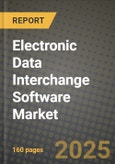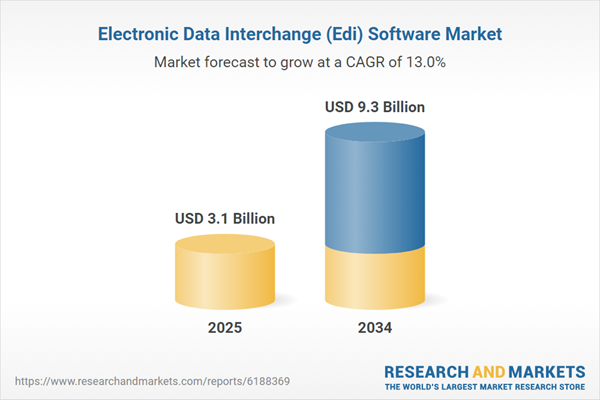The global Electronic Data Interchange (EDI) software market is experiencing robust growth, driven by increasing digitization, automation of business transactions, and the growing need for seamless data exchange across industries. EDI software enables businesses to electronically exchange structured data, such as purchase orders, invoices, and shipping notifications, improving efficiency and reducing manual processing errors. The rising adoption of cloud-based EDI solutions, integration with enterprise resource planning (ERP) systems, and compliance with industry-specific data exchange standards are key factors fueling market expansion. Additionally, the surge in e-commerce, supply chain globalization, and regulatory mandates for electronic invoicing are further accelerating EDI adoption. As organizations across retail, healthcare, logistics, and finance seek to optimize operations and enhance security in data exchange, the demand for EDI software is expected to grow significantly.
The EDI software market is witnessing significant advancements in automation, AI-driven data processing, and blockchain-based transaction security. AI-powered EDI systems are enhancing data validation, error detection, and predictive analytics to optimize supply chain and procurement processes. The increasing preference for cloud-based EDI solutions is driving the adoption of Software-as-a-Service (SaaS) models, enabling businesses to scale operations and reduce infrastructure costs. Moreover, the integration of EDI with Internet of Things (IoT) technologies is improving real-time tracking and visibility across global supply chains. Compliance with evolving data security regulations, such as GDPR and HIPAA, is also pushing vendors to develop more secure and encrypted EDI solutions. With businesses prioritizing digital transformation, EDI software is playing a pivotal role in streamlining B2B communication and transaction workflows.
The EDI software market is expected to evolve further with advancements in AI, automation, and real-time data analytics. The growing adoption of blockchain technology will enhance data integrity, transparency, and security in EDI transactions, reducing fraud risks. As businesses shift towards hyperautomation, AI-driven EDI platforms will automate complex workflows, reducing manual intervention. Cloud-based EDI solutions will become more dominant, offering seamless integration with ERP, warehouse management, and customer relationship management (CRM) systems. Additionally, the rise of 5G connectivity will facilitate faster and more efficient data exchange, improving supply chain agility. Emerging markets will also witness increased adoption of EDI software as businesses strive for global interoperability and compliance with international trade regulations. As digital ecosystems continue to expand, EDI solutions will play an integral role in optimizing business communications and operational efficiencies.
Key Insights: Electronic Data Interchange (Edi) Software Market
- AI-Powered EDI Solutions: Artificial intelligence is enhancing EDI efficiency by automating data validation, detecting anomalies, and optimizing transaction workflows in real time.
- Growth of Cloud-Based EDI: The shift towards cloud-based SaaS EDI platforms is enabling businesses to reduce IT infrastructure costs and improve scalability while ensuring seamless integration with existing systems.
- Blockchain for Secure Transactions: Blockchain technology is being integrated with EDI to enhance data security, ensure transaction transparency, and reduce fraud risks in digital exchanges.
- IoT-Enabled EDI Solutions: The combination of IoT and EDI is improving real-time tracking and supply chain visibility, enabling businesses to optimize logistics and inventory management.
- Regulatory Compliance and Data Security Enhancements: Stringent global regulations on data protection and privacy are driving the adoption of secure and encrypted EDI solutions across industries.
- Rising Demand for Supply Chain Optimization: Businesses are increasingly adopting EDI to automate supply chain transactions, improve operational efficiency, and minimize manual errors in B2B exchanges.
- Surge in E-Commerce and Digital Trade: The rapid growth of online commerce is driving demand for EDI solutions to facilitate seamless order processing, invoicing, and inventory management.
- Integration with ERP and Business Systems: The growing need for interoperability between EDI, ERP, and CRM platforms is boosting the adoption of advanced, fully integrated data exchange solutions.
- Government Mandates for Electronic Invoicing: Regulatory requirements for electronic invoicing and tax compliance are compelling businesses to adopt EDI solutions for seamless digital transactions.
- High Implementation Costs and Complexity: The initial investment and technical complexities of integrating EDI solutions with legacy systems pose challenges for small and medium-sized enterprises, limiting widespread adoption.
Electronic Data Interchange (Edi) Software Market Segmentation
By Component
- Software
- Services
By Type
- On-Premise
- Cloud Based
By Application
- Small and Medium-Sized Enterprises
- Large Enterprises
By Industry
- Automotive
- Banking
- Financial Services and Insurance
- Telecommunication and Information Technology
- Retail and Consumer Goods
- Manufacturing
- Healthcare
- Logistics
- Other Industry
Key Companies Analysed
- Boomi Inc.
- SPS Commerce Inc.
- MuleSoft LLC
- TrueCommerce Inc.
- Rocket Software Inc.
- Open Text Corporation
- Babelway SA
- Comarch SA
- Cleo Communications
- 1 EDI Source Inc.
- DiCentral Corporation
- Ediciones y Publicaciones del Comercio S.L.
- Intertrade Systems
- Epicor Software Corporation
- Business Systems Integrators
- Software AG
- Crossinx GmbH
- Data Masons Software LLC
- IBM Corporation
- The Descartes Systems Group Inc.
- Liaison International Inc.
- Oracle Corporation
- GXS Inc.
- Edifecs Inc.
- Symbology Inc.
- Optum360 LLC
- HighJump Software Inc.
- Jitterbit Inc.
- Actian Corporation
- Talend Inc.
Electronic Data Interchange (Edi) Software Market Analytics
The report employs rigorous tools, including Porter’s Five Forces, value chain mapping, and scenario-based modeling, to assess supply-demand dynamics. Cross-sector influences from parent, derived, and substitute markets are evaluated to identify risks and opportunities. Trade and pricing analytics provide an up-to-date view of international flows, including leading exporters, importers, and regional price trends.Macroeconomic indicators, policy frameworks such as carbon pricing and energy security strategies, and evolving consumer behavior are considered in forecasting scenarios. Recent deal flows, partnerships, and technology innovations are incorporated to assess their impact on future market performance.
Electronic Data Interchange (Edi) Software Market Competitive Intelligence
The competitive landscape is mapped through proprietary frameworks, profiling leading companies with details on business models, product portfolios, financial performance, and strategic initiatives. Key developments such as mergers & acquisitions, technology collaborations, investment inflows, and regional expansions are analyzed for their competitive impact. The report also identifies emerging players and innovative startups contributing to market disruption.Regional insights highlight the most promising investment destinations, regulatory landscapes, and evolving partnerships across energy and industrial corridors.
Countries Covered
- North America - Electronic Data Interchange (Edi) Software market data and outlook to 2034
- United States
- Canada
- Mexico
- Europe - Electronic Data Interchange (Edi) Software market data and outlook to 2034
- Germany
- United Kingdom
- France
- Italy
- Spain
- BeNeLux
- Russia
- Sweden
- Asia-Pacific - Electronic Data Interchange (Edi) Software market data and outlook to 2034
- China
- Japan
- India
- South Korea
- Australia
- Indonesia
- Malaysia
- Vietnam
- Middle East and Africa - Electronic Data Interchange (Edi) Software market data and outlook to 2034
- Saudi Arabia
- South Africa
- Iran
- UAE
- Egypt
- South and Central America - Electronic Data Interchange (Edi) Software market data and outlook to 2034
- Brazil
- Argentina
- Chile
- Peru
Research Methodology
This study combines primary inputs from industry experts across the Electronic Data Interchange (Edi) Software value chain with secondary data from associations, government publications, trade databases, and company disclosures. Proprietary modeling techniques, including data triangulation, statistical correlation, and scenario planning, are applied to deliver reliable market sizing and forecasting.Key Questions Addressed
- What is the current and forecast market size of the Electronic Data Interchange (Edi) Software industry at global, regional, and country levels?
- Which types, applications, and technologies present the highest growth potential?
- How are supply chains adapting to geopolitical and economic shocks?
- What role do policy frameworks, trade flows, and sustainability targets play in shaping demand?
- Who are the leading players, and how are their strategies evolving in the face of global uncertainty?
- Which regional “hotspots” and customer segments will outpace the market, and what go-to-market and partnership models best support entry and expansion?
- Where are the most investable opportunities - across technology roadmaps, sustainability-linked innovation, and M&A - and what is the best segment to invest over the next 3-5 years?
Your Key Takeaways from the Electronic Data Interchange (Edi) Software Market Report
- Global Electronic Data Interchange (Edi) Software market size and growth projections (CAGR), 2024-2034
- Impact of Russia-Ukraine, Israel-Palestine, and Hamas conflicts on Electronic Data Interchange (Edi) Software trade, costs, and supply chains
- Electronic Data Interchange (Edi) Software market size, share, and outlook across 5 regions and 27 countries, 2023-2034
- Electronic Data Interchange (Edi) Software market size, CAGR, and market share of key products, applications, and end-user verticals, 2023-2034
- Short- and long-term Electronic Data Interchange (Edi) Software market trends, drivers, restraints, and opportunities
- Porter’s Five Forces analysis, technological developments, and Electronic Data Interchange (Edi) Software supply chain analysis
- Electronic Data Interchange (Edi) Software trade analysis, Electronic Data Interchange (Edi) Software market price analysis, and Electronic Data Interchange (Edi) Software supply/demand dynamics
- Profiles of 5 leading companies - overview, key strategies, financials, and products
- Latest Electronic Data Interchange (Edi) Software market news and developments
Additional Support
With the purchase of this report, you will receive:- An updated PDF report and an MS Excel data workbook containing all market tables and figures for easy analysis.
- 7-day post-sale analyst support for clarifications and in-scope supplementary data, ensuring the deliverable aligns precisely with your requirements.
- Complimentary report update to incorporate the latest available data and the impact of recent market developments.
This product will be delivered within 1-3 business days.
Table of Contents
Companies Mentioned
- Boomi Inc.
- SPS Commerce Inc.
- MuleSoft LLC
- TrueCommerce Inc.
- Rocket Software Inc.
- Open Text Corporation
- Babelway SA
- Comarch SA
- Cleo Communications
- 1 EDI Source Inc.
- DiCentral Corporation
- Ediciones y Publicaciones del Comercio S.L.
- Intertrade Systems
- Epicor Software Corporation
- Business Systems Integrators
- Software AG
- Crossinx GmbH
- Data Masons Software LLC
- IBM Corporation
- The Descartes Systems Group Inc.
- Liaison International Inc.
- Oracle Corporation
- GXS Inc.
- Edifecs Inc.
- Symbology Inc.
- Optum360 LLC
- HighJump Software Inc.
- Jitterbit Inc.
- Actian Corporation
- Talend Inc.
Table Information
| Report Attribute | Details |
|---|---|
| No. of Pages | 160 |
| Published | October 2025 |
| Forecast Period | 2025 - 2034 |
| Estimated Market Value ( USD | $ 3.1 Billion |
| Forecasted Market Value ( USD | $ 9.3 Billion |
| Compound Annual Growth Rate | 13.0% |
| Regions Covered | Global |
| No. of Companies Mentioned | 30 |









